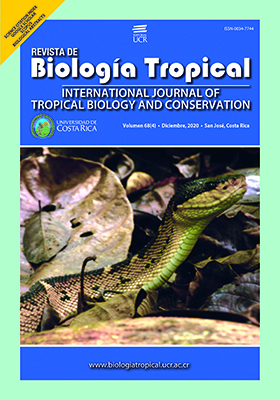Resumen
Introducción: El tamaño corporal es un rasgo importante para determinar la respuesta de los endotermos a los requerimientos que exigen las zonas frías, por lo cual se espera una tendencia hacia el incremento del tamaño corporal al aumentar la altitud y la latitud. Sin embargo, se conoce poco acerca de la validez de esta regla ecomorfológica, conocida como la regla de Bergmann, para endotermos pequeños en gradientes altitudinales tropicales. Objetivo: Con el fin de entender los efectos de la variación ambiental sobre el tamaño corporal, se evaluó sí la variación interespecífica en la masa corporal de endotermos tropicales pequeños se ajusta a la regla de Bergmann a lo largo de gradientes de elevación. Métodos: Se compilaron datos sobre los rangos de distribución altitudinal y los tamaños corporales de 133 especies de colibríes en Colombia. Posteriormente, se evaluó la asociación entre la masa corporal y el punto medio de distribución altitudinal de los colibríes mediante análisis de mínimos cuadrados generalizados filogenéticos (PGLS) bajo diferentes modelos evolutivos. Resultados: La evolución de la masa corporal se ajustó mejor a un modelo de evolución Early Burst, mientras que el rango de elevación al modelo evolutivo lambda de Pagel; lo que indica que la tasa de evolución es desacelerada para el tamaño del cuerpo, mientras es lenta y constante para el rango de elevación. Además, el análisis de regresión filogenética indica que la masa corporal y el rango de elevación están positiva y ligeramente asociados (R2 = 0.036). Conclusiones: De acuerdo con lo esperado por la regla de Bergmann, los resultados indican que los colibríes tienden a ser más grandes a mayores altitudes. Sin embargo, esta asociación es más débil de lo esperado para aves no paseriformes de tamaño pequeño como los colibríes. Por lo tanto, los resultados sugieren que las variaciones ambientales a lo largo de gradientes de elevación no tienen una influencia fuerte sobre el tamaño corporal de endotermos pequeños como los colibríes.
##plugins.facebook.comentarios##

Esta obra está bajo una licencia internacional Creative Commons Atribución 4.0.
Derechos de autor 2020 Oscar E. Murillo-García, Maria E. De la vega, Katherine Pérez-Castillo



